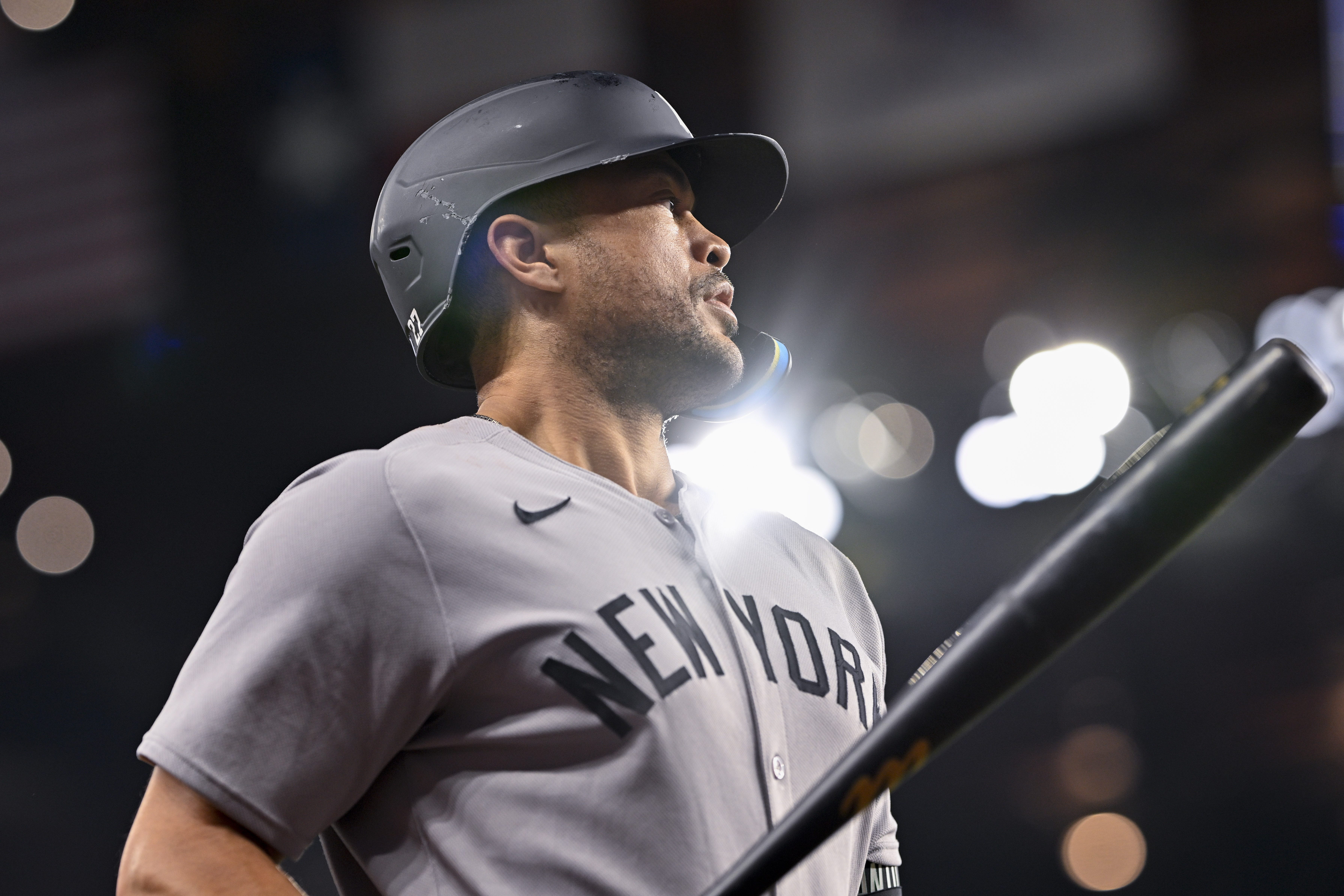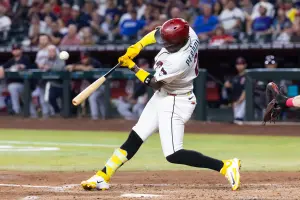
Swings and Takes: Starting with the King of Contact
The author, Tanner Smith, previously wrote the Arsenal Report for BHQ from 2021-2022, before joining the Detroit Tigers Front Office in 2023 as an Analytics Associate. He will be writing this column for 2024, along with contributing to the Daily Callups section.
Discipline. This is a word that has drastically different meanings to different people. To someone like LeBron James, it means scripting out every minute of his day to maximize his performance at an age where most high-level athletes must use the caveat “former” and are learning how to golf. For others, it means eating two scoops of ice cream instead of reaching for that third scoop. For baseball hitters, it can mean both training and dietary control, but also has a definition unique to their craft: the art of the take. From the days of Ted Williams proselytizing the value of “getting a good ball to hit” to the contemporary masters of the art, such as Joey Votto (1B, TOR) and Juan Soto (OF, NYY), we often think of plate discipline as taking a lot of pitches and walking. Brad Pitt and Jonah Hill famously delivered this message to even the non-baseball watching public in the screen adaptation of a book most of them never read.
Take charge of your league in 2024 with a BaseballHQ.com subscription that unlocks articles like these all season long. Winning. Fantasy baseball. Insight.
While the walk is a glorious and valuable pillar of generating hitting value, it is far from the end-all be-all. Even the full quote from Williams is not about trying to walk, but to make pitchers deliver hittable pitches and clobbering those pitches. Williams was novel in his day for creating charts that broke the strike zone down into 77 baseballs and estimating his batting average in these zones, but in 2024 we no longer have to guess. That is the premise of this column: quantifying what hitters should be swinging at and what they should not be swinging at. The goal will be to dissect hitter swing decisions, both the pitches they swing at and the pitches they take and see how they impact performance over time. Before we dive into a player example, we need to make sure we are working with a shared vocabulary. Here are some of the statistics that will be frequently referenced within the walls of Swings and Takes, with many of these definitions coming from the FanGraphs glossary and Baseball Savant:
- Swing% - Percentage of pitches swung at
- O-Swing% – (Outside the Zone Swing Percentage) – Swings at pitches outside the strike zone divided by pitches outside the zone
- Z-Swing% - (Inside the Zone Swing Percentage) – Swings at pitches inside the zone divided by pitches inside the zone
- Contact% - (Contact Percentage) – Contact made divided by swings
- SwStr% - (Swinging Strike Percentage) – Swinging strikes divided by total pitches
- Whiff% - often confused with SwStr%, same numerator (swinging strikes), different denominator (total swings)
- Chase% - Swings at pitches outside the zone divided by the number of pitches outside the zone
- Meatball% - percentage of pitches in the very middle of the zone
- Heart Zone – pitches in the middle of the zone. Slightly broader definition than meatballs
- Shadow Zone – borderline pitches. The kind that causes umpire grousing from both sides
- Chase Zone – pitches clearly out of the zone. Not to be confused with Chase%, which is just referring to pitches outside the strike zone, these are pitches that make you wonder “what is that guy swinging at”
These are the basic building blocks that we will be working with in this column, with room to stack more Legos on top and combine. For example, Chase Contact% is simply Contact% on Chase pitches, combining Contact% and Chase%. Meatball Swing% is simply Swing% on pitches in the Meatball zone. Now that we have established this foundation, it is time to get into a player analysis, starting at the top of the batting average rankings in 2023.
Arraez Defies Stuff Revolution and Dominates Shadow Zone
In a time where MLB pitching velocity is higher than it has ever been in the pitch tracking era (94.1 MPH average fastball velocity in 2023), pitchers are throwing less fastballs than ever, (32.3% in 2023) and pitchers are optimizing pitch shapes in biomechanical labs, it has never been harder to contact the ball. While many hitters have taken the approach of trying to optimize the damage that they can wreak on the pitches they do hit, one man has taken a stubborn stand against the tyranny of the whiff: Luis Arraez. Arraez would have fit right into the eras of Ty Cobb and “Wee Willie” Keeler (sadly no PlayerLink pages here), with Arraez’s refusal to strike out and uncanny ability to “hit’em where they ain’t”, demonstrated by his career 7.5 K% and .326 BA. Arraez had his best season in 2023, posting a .354 BA with a higher BB% (5.7%) than K% (5.5%), which were both career lows. How he got there is a fascinating case of adjustments and counter adjustments.
The scouting report on Luis Arraez was likely pretty simple going into 2023: he was going to swing often and usually make contact, but rarely turn that contact into anything more than a single. Among qualified hitters in 2022 Arraez had the 12th lowest ISO (Isolated Power, SLG – BA) at .104, which was tied with his rookie season of 2019 for his career high. Pitchers seemed to home in on this in 2023 by attacking Arraez in the strike zone: 52.2% of the pitches he saw in 2023 were in the strike zone, which was way up from his 47.9% mark in 2022. Pitchers seemed to not be particularly careful with where these strikes were located on Arraez, demonstrated partially by his Meatball% going up to 8.9% in 2023 from 6.8% in 2022. One possible rationale to do this is that Arraez was going to hit his singles regardless, but walking him, especially in his usual position as leadoff hitter, was a zero-value proposition, as they were not likely avoiding extra base damage.
Most hitters would respond to pitchers being more aggressive in the strike zone against them in two ways: swing more and swing with more aggression to try to drive the ball. If you have been following along with the type of hitter Arraez is, you likely have a guess on which component of this two-pronged response Arraez chose. True to form, Arraez decided to take the singles that the pitchers were “giving” him while restraining any potential thirst for more. He ramped up the amount he swung drastically, up 8.1% in 2023 (51.0%) compared to 42.9% in 2022, the largest increase of any qualified hitter between 2022 and 2023. We can see the increase in aggression start to really kick in during the month of May in 2023, when pitchers started to attack him in the zone and Arraez countered by swinging more:
Arraez In Zone% by Month 2023
Most hitters that increase their Swing% would see a corresponding drop in Contact%, as more aggression usually leads to more chase, and therefore more whiffs. Arraez indeed chased more in 2023, up to 31.8% in Chase% compared to 24.1% in 2022, and like most hitters started chasing more when he started swinging more:
Arraez Chase% by Month 2023
There is one key difference between Arraez and most other hitters, however: he refuses to whiff even when he chases. Arraez posted an insane 87.2% Chase Contact% in 2023, which was down from an even more insane 89.4% mark in 2022. For context, the rest of the league only posted a 58% Chase Contact% in 2023. Arraez seems to have realized that he can essentially hit everything after a huge jump in Chase Contact% from 2021 to 2022 (89.4% in 2022 compared to 78.1% in 2021). In addition, because he is not trying to drive the ball, contact for the sake of contact suits him perfectly, as we will see in a little bit.
Pitchers made their Arraez adjustments in 2023 (attack in the zone) Arraez countered with his own adjustment (swing more). The key question we are after here is not what happened in the past, but what pitchers and Arraez may do going into 2024. To be clear there is no magic formula to get Luis Arraez out: he is the contemporary embodiment of Greg Maddux’s quote about Tony Gwynn, where Maddux said that “if a pitcher changes speeds, every hitter is helpless, limited by human vision. Except for that (expletive) Tony Gwynn.” Pitchers do have to throw the ball 60 feet 6 inches to Arraez, however, so they will choose a plan to maximize their chances. One possible approach would be to try to cash in on Arraez’s newfound aggression from last year and try to get him to put “pitcher’s pitches” in play. Here is a chart of Arraez’s results in 2023 against pitches in the heart, shadow, and chase zones:
Arraez Results by Pitch Zone:
| Statistic | Heart | Shadow | Chase |
| PA | 248 | 288 | 61 |
| Swing% | 71.10% | 58.10% | 20.00% |
| Whiff% | 6.00% | 7.60% | 14.70% |
| BA | 0.376 | 0.357 | 0.24 |
| wOBA | 0.375 | 0.368 | 0.317 |
| EV | 91.1 | 86.5 | 79.5 |
Arraez’s shadow zone numbers pop here, as results wise it did not really matter in 2023 if he swung at a pitch in the heart (near the middle) or shadow (edge of the zone). He showed a little bit of humanity by getting significantly worse if you could get him to the chase zone. The problem is that Arraez did not actually swing at pitches in the chase zone very often, as we can see by the PA total, with only 61 PAs ending in him swinging at a chase zone pitch. Even when he did swing at a terrible pitch in the chase zone, he still made way more contact than the average MLB hitter did against ALL zones (14.7% for Arraez against chase zone pitches, average MLB hitter Whiff% of 22.7%). That chase zone contact is good for pitchers though: the key to gettting Arraez out is getting him into situations where he is tempted to swing at those pitches. It is not easy to use Arraez’s strength against him, as he does not have shadow zone issues the way that other hitters do, so the only potential remedy is to make Arraez expand outside the shadow zone.









